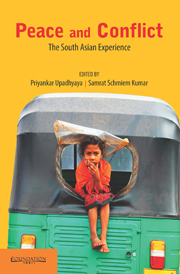Book contents
- Frontmatter
- Contents
- Foreword
- Preface
- Introduction
- 1 Conflict Resolution and Peacebuilding: Ideas, Approaches and Debates
- 2 Changing Perspectives on Peace Studies in South Asia
- 3 Peace Pedagogies in South Asia: Interreligious Understanding
- 4 Responses of Communities to Social Tension
- 5 Plurality of Peace, Non-violence and Peace Works in India
- 6 Education and Culture of Peace: Engaging with Gandhi
- 7 Structural Violence and Human Security: Gandhi's Visions
- 8 Women and the Peace Process in Nepal
- 9 Quest for Peace and Justice in Pakistan: Lawyers' Non-violent Resistance
- 10 Antinomies of Democracy and Peace in Nepal
- 11 Post-armed Conflict Trajectories in Sri Lanka
- 12 Environmental Security and Conflict in Bangladesh: Nature, Complexities and Policies
- Contributors
- Bibliography
- Index
7 - Structural Violence and Human Security: Gandhi's Visions
Published online by Cambridge University Press: 05 October 2014
- Frontmatter
- Contents
- Foreword
- Preface
- Introduction
- 1 Conflict Resolution and Peacebuilding: Ideas, Approaches and Debates
- 2 Changing Perspectives on Peace Studies in South Asia
- 3 Peace Pedagogies in South Asia: Interreligious Understanding
- 4 Responses of Communities to Social Tension
- 5 Plurality of Peace, Non-violence and Peace Works in India
- 6 Education and Culture of Peace: Engaging with Gandhi
- 7 Structural Violence and Human Security: Gandhi's Visions
- 8 Women and the Peace Process in Nepal
- 9 Quest for Peace and Justice in Pakistan: Lawyers' Non-violent Resistance
- 10 Antinomies of Democracy and Peace in Nepal
- 11 Post-armed Conflict Trajectories in Sri Lanka
- 12 Environmental Security and Conflict in Bangladesh: Nature, Complexities and Policies
- Contributors
- Bibliography
- Index
Summary
Introduction
South Asian discourses on peace can draw much from Gandhian visions. His comprehensive approach to peace reflected in his oft-cited statement, ‘Earth provides enough to satisfy every man's need, but not every man's greed’, reveals a unique synergy between peace and sustainable development. Peace for Gandhi was not just the absence of war or violence, but also a pathway to expand human potential without hurting others in the community or in the larger ecosystem. No wonder Gandhi continues to influence the global thought process despite political and cultural transformations. Numerous thinkers and activists across the world swear by Gandhi's philosophy, and no global dialogue on peace can progress without reference to his ideas. Amidst the current global crises marked by a rising scale of violence, a worsening ecological crisis, terrorism and discriminatory patterns of globalization, Gandhian expressions on peace and sustainability assume critical salience.
Gandhi envisioned a holistic yet critical vision of peace that rejected violence in its entirety. He not only abhorred wars and killing under any guise, but also addressed the insidious ramifications of ‘structural violence’, embedded in structures and cultures. His disavowal of violence amidst the gravest of provocations makes him the most inveterate proponent of nonviolent methods to achieved peace. He firmly believed that positive peace could be brought about only by peaceful means and never by non-peaceful means (Galtung 1996). He believed that the modern state based on force is incapable of dealing with the forces of disorder, whether external or internal. Gandhi’s vision has inspired multiple streams of pedagogy and new thinking around such areas as sustainable development, human security and structural violence.
- Type
- Chapter
- Information
- Peace and ConflictThe South Asian Experience, pp. 122 - 139Publisher: Foundation BooksPrint publication year: 2014

